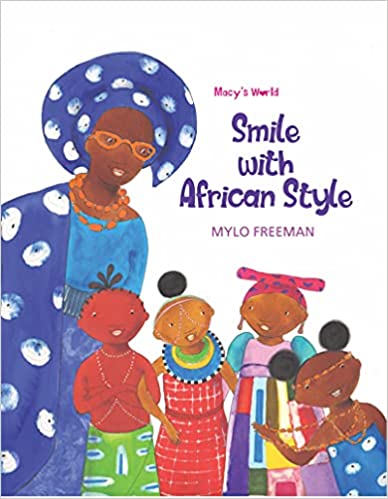Smile with African Style
 Smile with African Style
Smile with African Style
Picture Book / Ages 5-8
Macy World
November 15, 2021

It's a special day in Macy's classroom as all the children come in dressed up in their most stylish African clothing! Zahra's Ethiopian dress is covered in beads, while Malika's Namibian outfit is bursting with colours. And who is hiding behind that elephant mask from Cameroon? No two outfits are the same, in this beautiful and varied parade of clothing from across Africa!
Smile with African Style is a brilliantly illustrated, stunningly accurate picture book that exposes young readers to the beauty, richness, and diversity of African culture through formal dress. The book is the second story in a new series entitled Macy’s World by critically acclaimed author/illustrator Mylo Freeman, whose previous work includes the widely celebrated Princess Arabella Series. Set in an elementary school classroom, the book follows Macy and her classmates as they exhibit an African fashion showcase inspired by their teacher’s Ankara print dress.
The story is anchored by large-scale maps of Africa displayed center-page at the beginning and end of the text. Smaller maps and globes are interspersed throughout the narrative, often with children’s hands abutting, pointing to, or placed atop them. Freeman’s strategic centering of African maps alongside young students reinforces the continent’s vastness while suggesting that its distinct histories, cultures, and peoples are within reach for audiences of all ages.
Through ten carefully curated ensembles representing the Masai of Kenya, the Ashanti people of Ghana, the Tutsi warriors of Rwanda, and the Herero women of Namibia, among others, Freeman cleverly teaches readers the utter truth that Africa is a continent not a country; a far-reaching, heterogeneous area comprising multiple diverse communities not a homogenous space. Smile with African Style appropriately situates Africa as a generative site of creative cultural expression that ignites admiration and inquiry in equal measure.
Each page offers a riotous array of colors set against a stark white backdrop, affording even greater detail to the many layers and elements of African attire on view. For example, Malaika’s traditional Ndebele outfit is wholly complete with isephephetu, a cloth apron adorned with glass beads; isigolwani, thick, beaded ankle and neck bracelets; dzilla, gold neck ringlets; and amacubi, a vibrant, multi-colored blanket cape. Similarly, Miss Brown’s Igbo ensemble includes a blouse, shawl, a richly symbolic coral necklace, as well as ichafo, an ornately tied head wrap and ogodo, an ankle-length loincloth wrapper topped with a narrow belt. The deep blue hues and circular patterning of Macy and Miss Brown’s dresses signal both the visual semiotics and the resist-dyed techniques of indigo textile traditions typical throughout much of West Africa. Freeman’s illustration is remarkably precise in its depiction of Africa’s myriad vernacular textiles and ceremonial regalia.
Smile with African Style is at once charming and instructive. Its visual force is complemented by an accessible storyline that emphasizes children’s voices and viewpoints. Emboldened blue font accentuates the students’ ideas, announces the origins of their outfits, and builds anticipation for the next fashion reveal. While the images draw readers in, simple, one-line sentences and limited, objective narration focus attention on the children, their excitement about the clothes they wear and the communities they represent. The strength of the book rests in its ability to simultaneously capture, reflect, and fulfill children’s curiosity about the world in which they live – both for the characters of the text and the reader alike. Macy’s classroom is the reader’s classroom.
While the educational quality of the book might have been heightened by incorporating indigenous words throughout the text, this added element may have complicated the narrative in counter-productive ways. Additionally, in effort to dissuade exoticization of Africa, it might have been helpful for the author to share that the exhibited ensembles are not every day attire but instead generally worn for special occasions.
Overall, Smile with African Style is a joyful book that restores the African art of teaching through storytelling.
Lanisa S. Kitchiner, Ph.D.
Chief, African and Middle Eastern Division, Library of Congress
Published in Africa Access Review (April, 6, 2022)
Copyright 2022 Africa Access
